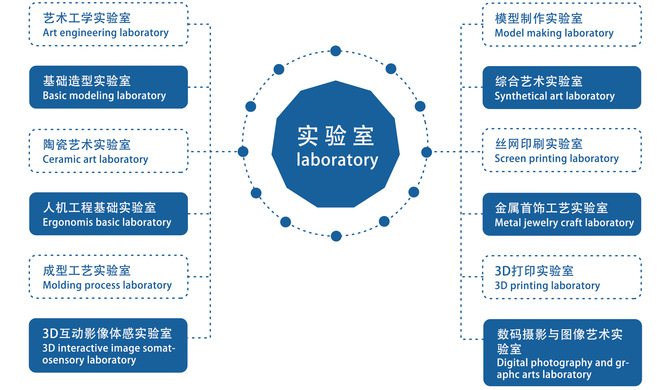
Established in January 2006 on the foundations of the former Departments of Industrial Design and Art and Design, the Experimental Center has, after more than a decade of rapid growth, evolved into a comprehensive hub for innovation and practice. It encompasses 12 specialized laboratories and 4 computer-aided teaching rooms, including the Basic Modeling Laboratory, Ceramic Art Laboratory, Basic Ergonomics Laboratory, Molding Process Laboratory, Model Making Laboratory, Art Engineering Laboratory, Fiber Art Laboratory, Screen Printing Laboratory, 3D Interactive Imaging Laboratory, Digital Photography and Graphic Arts Laboratory, Metal Jewelry Craft Laboratory, and 3D Printing Laboratory. These facilities provide high-quality experimental training, hands-on practice, and digital teaching services for all majors within the School.
The Center operates under a dual-level management system with a director responsible for overall coordination. It currently employs 6 full-time staff members and more than 20 laboratory instructors, covering a total space of 1,600 square meters. Over 90% of its courses are comprehensive and design-oriented, ensuring that students gain both breadth and depth in their learning experiences.
The mission of the Center is to strengthen practical training, expand opportunities for interdisciplinary exploration, and enhance students’ design and innovation capabilities. By establishing an open curriculum framework, it es cross-disciplinary collaboration across ECUST, fostering a vibrant ecosystem of teaching, research, and practice. Its vision is to build a first-class, comprehensive, and distinctive experimental teaching base for art and design, offering students a shared platform for exploration and creativity.
The Center supports undergraduate innovation projects (USRP), new experimental courses, graduation projects, and both undergraduate and postgraduate competitions. All laboratories are open to students across the School, providing spaces for creative design, experimentation, and achievement. As a result, the Center has become both a hub of student innovation in industrial design, art design, and advertising, and a platform for showcasing pioneering achievements.
With its distinctive structure and forward-looking vision, the Center continues to cultivate high-quality graduates—talented students with strong practical abilities, a solid academic foundation, and a deep sense of creativity and innovation—who are well prepared to contribute to society.